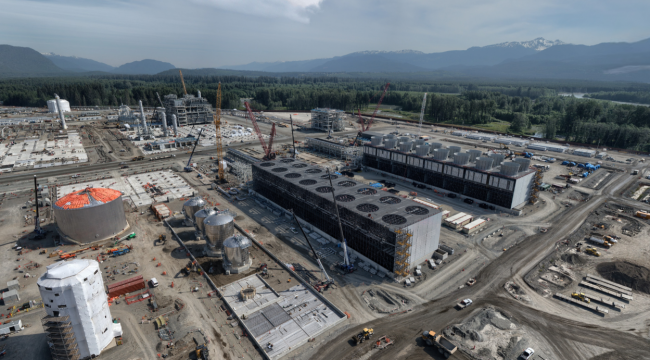Articles Menu

Mar. 2, 2023
Oil giant Shell recently let it slip that it is prepared to build the second phase of LNG Canada, Canada’s largest LNG terminal in Kitimat, B.C., as a gas-fired plant. If the project is built, the province might as well say goodbye to any chance of meeting its climate targets.
There are two ways to liquify natural gas: either by using gas-powered turbines or by using e-drives, which use electricity to compress the gas. Burning gas to power compressors is extremely emissions-intensive. In fact, when the gas-fired Phase 1 of LNG Canada comes online in 2025, it will become the largest single source of climate pollution in B.C.
Since 2018, when the decision to build the first phase of the terminal was made, provincial policymakers have been tying themselves in knots to try to make those emissions fit into B.C.’s climate plan. According to the province’s most recent Climate Accountability Report, they are still coming up just short and will miss B.C.'s 2025 target by 15 per cent and its 2030 target by three per cent.
However, if LNG Canada’s Phase 2 doubles those emissions targets, which have been a key political objective of the NDP since coming to office, any climate targets will become completely unattainable. A fact that Shell is well aware of because its chief B.C. lobbyist, Skye McConnell, serves on the province’s Climate Solutions Council, which advises the government on climate policy.
So if LNG Canada’s Phase 2 emissions will destroy B.C.'s climate targets and it’s a political imperative for David Eby’s government to meet those, something has to give. This is why I believe Shell’s true intentions are to use this leverage to extract an enormous package of fossil fuel subsidies from provincial taxpayers in exchange for electrifying their project, including a multibillion-dollar transmission line and discounted electricity prices.
How can I be so sure this is what Shell is up to? Because it has done this before. In 2018 when the investment decision for Phase 1 of LNG Canada was being made, Shell extracted a package of special tax breaks and fossil fuel subsidies from both the provincial and federal governments by threatening to cancel the project if newly elected premier John Horgan didn’t use public money to help guarantee the project was profitable.
They knew Horgan, who was governing with a razor-thin minority government after the 2017 election that basically ended in a tie, badly wanted to be seen to be a good manager of the economy. If Shell packed up and left Kitimat, the B.C. Liberals would label the new premier a job killer and that would likely cost him his re-election.
Shell leveraged this into a generous package of tax breaks from the province. On top of that, the federal government kicked in another $275 million to cover the cost of higher-efficiency gas turbines.
So Shell, which incidentally just reported record profits in 2022, is trying again to put the screws to a newly elected premier to get the public to help cover the ballooning costs of this project.
However, the economics of this project has always been marginal at best. As a new report from the Institute for Energy Economics and Financial Analysis reminds us, the costs of building LNG infrastructure in B.C. is much higher than in competing jurisdictions.
Since 2018 when the decision to build the first phase of the LNG terminal was made, provincial policymakers have been tying themselves in knots to try to make those emissions fit into B.C.’s climate plan, writes @svenbiggs @standearth #bcpoli - Twitter
To connect LNG Canada to fracked gas from northeastern B.C., the 670-kilometre-long Coastal GasLink pipeline must cross two mountain ranges and 625 streams, creeks, rivers and lakes. Workers for both the pipeline and the LNG terminal must be flown in and housed in work camps, which leads to higher labour costs.
Compare that to competing projects on the U.S. Gulf Coast, which has easy access to a vast network of existing gas infrastructure and a large pool of local skilled workers. A fact that was underlined by Coastal GasLink’s recent announcement that the cost of the pipeline had risen to $14 billion, more than double the original $6.2-billion price tag.
If LNG Canada is not even competitive with other LNG terminals, why is Shell still trying to build it? Shell is counting on politicians to offer the company enough fossil fuel subsidies to make its business profitable.
But without public money, no version of this project will be built. It's Premier Eby who has the leverage in this situation. By signalling that his government is done subsidizing fossil fuels and telling Shell that if it decides to build Phase 2 then it will have to pay their fair share of taxes, he can force Shell to put its record profits where its mouth is.
Sven Biggs is the Canadian oil and gas program director at Stand.earth, an international non-profit environmental organization with offices in Canada and the United States.